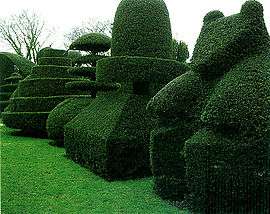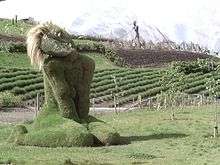Living sculpture
Living sculpture is any type of sculpture that is created with living, growing grasses, vines, plants or trees. It can be functional and/or ornamental. There are several different types of living sculpture techniques, including topiary (prune plants or train them over frames), sod works (create sculptures using soil and grass or moss), tree shaping (growing designs with living trees) and mowing and crop art (create patterns or pictures with plants or in lawns). Most living sculpture technique requires horticultural skills, such as grafting or pruning, to create the art.
History
Sculptors through the ages have traditionally worked with non-living media such as clay, plaster, glass, bronze, or even plastic. Although sculpting plants isn’t a new idea (bonsai or topiary have long historical traditions), its recent rediscovery by artists, horticulturalists, gardeners, and young people has given living sculpture an innovative popularity.
Living sculpture offers a highly appealing blend of art and science. It’s a creative process that gives the sculptor a chance to bring their own unique vision to life (literally!) Creating a living sculpture is also a collaborative process that can bring artistic minds, logistical minds, and scientific minds together. As a team project, creating a living sculpture can be about more than just art or science. A team collaborating to design and build a living sculpture can learn a lot about themselves, each other, and what partnerships are all about - while making a functional and/or ornamental public sculpture in their community.
Topiary

One of the older and more familiar kinds of living sculpture, topiary is the art of growing dense, leafy plants and pruning them into a form, or training them over a frame, to create a three-dimensional object. It relies on pruning and training to give shape to an existing plant. It also can involve training a plant to fill in a form.
Topiary is one type of living sculpture that has gone in and out of favor through the ages. A few historical highlights of its importance and use:
- Earliest references of topiary date back to 23-79 A.D.
- It was immensely popular in Ancient Rome using cypress trees, but after the fall of Rome, topiary fell out of favor for several hundred years.
- It returned in medieval times as a way of training fruit plants, and then was again rediscovered during the Italian Renaissance.
- The Dutch in the 15th century became intrigued with creating topiary in animal shapes, as did 17th century England; the French preferred creating topiary in geometric designs with strict symmetry.
- 18th century, topiary fell out of favor again, and a natural look returned.
- Victorians brought back topiary, adding in new plants and details.
- Topiary spread to North America at Williamsburg, Virginia, around 1690.
- As houseplants became popular in the 1950s and 1960s, topiary moved indoors.
Bonsai
Bonsai is the art of aesthetic miniaturization of trees, or of developing woody or semi-woody plants shaped as trees, by growing them in containers. Cultivation includes techniques for shaping, watering, and repotting in various styles of containers.
Turf and sodworks

Turf- or sod-works are created from grass or moss and soil. This type of art has roots in the Land Art movement (also known as the Earthworks or Earth Art movement) that emerged in the late 1960s and early 1970s. During this period, landscape and the work of art began to be viewed as linked. Sculptures were not just placed in the landscape; rather the landscape became the very means of their creation. These works often existed in the open, located well away from communities, and were left to change under natural conditions. Many of the first works were created in the deserts of Nevada, Utah, New Mexico, and Arizona. They did not, or were not meant to last, and now exist only as recordings or photos.
Works made from the earth are changing the way in which people view art, and often are used to promote environmental awareness. These works may be created on waste sites, and may draw attention to land reclamation and urban restoration efforts. Recent earth artists have worked with soil, sod, or moss to create forms that may be intimate and small, or large and multi-acre. They may be cut out of the earth, or formed with soil. They may give a nod to the past, or they may be cutting edge and contemporary in design. Some examples include labyrinths and mazes, animal and human forms, geometric shapes, and furniture.
Tree shaping

Chairs, ladders and other shapes made from living trees are some examples of tree shaping. Some types of tree shaping involve horticultural practices such as weaving, grafting, training, and/or shaping young, living trees into desired shapes.
Creative Mowing and Crop Art

Crop artists plan in advance on paper, and often work with farmers, special equipment, and a diversity of crops to create multi-acre masterpieces that are viewed from the air and are captured via photographs. They draw on a variety of impressionist, surrealist, and modernist roots in their designs, and some are downright quirky: . Stan Herd is a renowned Crop artist.
See also
- Axel Erlandson
- Crop circles
- Earthworks
- Espalier
- Gilroy Gardens
- John Krubsack
- Topiary
- Tree shaping
- Pleaching
- Crop art
References
Further reading
Topiary
- The Complete Book of Topiary. Gallup, Barbara; Reich, Deborah 1987. Workman Publishing, N.Y
- Quick and Easy Indoor Topiary. Jones, Chris 1998. Storey Books; Pownal, Vermont
Tree Shaping
- Living Willow Sculpture. Warnes, Jon 2001. Search Press.
- Arborsculpture: Solutions for a small planet. Reames, Richard 2002. Arborsmith Studios.
- Tricks With Trees: Land Art for the Garden by Ivan Hicks and Richard Rosenfeld 2007
Tree Sculpture
- Making Bentwood Trellises, Arbors, Gates & Fences. Long, Jim 1998. Storey Publishing.
Creative Mowing & Crop Art
- Lawnscapes: Mowing Patterns to Make Your Yard a Work of Art. Parfitt, David 2006. Quirk Books.
- Crop Art and Other Earthworks. Herd, Stan 1994. Harry N. Abrams Publishers.
- Crop Circles: Art in the Landscape. Pringle, Lucy 2007. Frances Lincoln.
External links
Living Sculpture
- The Cornell Garden-Based Learning Institute's Living Sculpture Website: http://www.hort.cornell.edu/livingsculpture
- Lovallo Living Sculpture Turf and Tree Works
Turf or Sod Works
- HGTV at Home: Sod Sofas - Landscape architect Greg Tate demonstrates how to build a sod sofa for your lawn
- Sprout a Couch: Lawn Furniture for Literalists - Article by Greg Tate in Ready Made Magazine about how to build a sod sofa.
Tree Shaping
Creative Mowing & Crop Art
- Stan Herd: Crop Art and Other Earthworks - From 160-acre (0.65 km2) plowed portraits to one quarter acre intimate stone designs, artist Stan Herd’s work has become a platform for discussion of mankind's contemporary relationship to the land.
- Lawn Striping and Lawn Patterns: How Do They Work? - A good explanation on how lawn striping works and what can be done to increase the lawn striping effect.